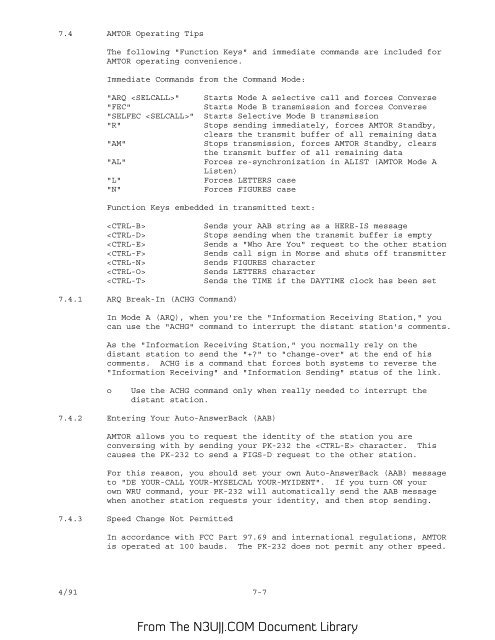Create successful ePaper yourself
Turn your PDF publications into a flip-book with our unique Google optimized e-Paper software.
7.4 AMTOR <strong>Operating</strong> Tips<br />
The following "Function Keys" and immediate commands are included for<br />
AMTOR operating convenience.<br />
Immediate Commands from the Command Mode:<br />
"ARQ " Starts Mode A selective call and forces Converse<br />
"FEC"<br />
Starts Mode B transmission and forces Converse<br />
"SELFEC " Starts Selective Mode B transmission<br />
"R"<br />
Stops sending immediately, forces AMTOR Standby,<br />
clears the transmit buffer of all remaining data<br />
"AM"<br />
Stops transmission, forces AMTOR Standby, clears<br />
the transmit buffer of all remaining data<br />
"AL"<br />
Forces re-synchronization in ALIST (AMTOR Mode A<br />
Listen)<br />
"L"<br />
Forces LETTERS case<br />
"N"<br />
Forces FIGURES case<br />
Function Keys embedded in transmitted text:<br />
<br />
<br />
<br />
<br />
<br />
<br />
<br />
Sends your AAB string as a HERE-IS message<br />
Stops sending when the transmit buffer is empty<br />
Sends a "Who Are You" request to the other station<br />
Sends call sign in Morse and shuts off transmitter<br />
Sends FIGURES character<br />
Sends LETTERS character<br />
Sends the TIME if the DAYTIME clock has been set<br />
7.4.1 ARQ Break-In (ACHG Command)<br />
In Mode A (ARQ), when you're the "Information Receiving Station," you<br />
can use the "ACHG" command to interrupt the distant station's comments.<br />
As the "Information Receiving Station," you normally rely on the<br />
distant station to send the "+?" to "change-over" at the end of his<br />
comments. ACHG is a command that forces both systems to reverse the<br />
"Information Receiving" and "Information Sending" status of the link.<br />
o<br />
Use the ACHG command only when really needed to interrupt the<br />
distant station.<br />
7.4.2 Entering Your Auto-AnswerBack (AAB)<br />
AMTOR allows you to request the identity of the station you are<br />
conversing with by sending your <strong>PK</strong>-<strong>232</strong> the character. This<br />
causes the <strong>PK</strong>-<strong>232</strong> to send a FIGS-D request to the other station.<br />
For this reason, you should set your own Auto-AnswerBack (AAB) message<br />
to "DE YOUR-CALL YOUR-MYSELCAL YOUR-MYIDENT". If you turn ON your<br />
own WRU command, your <strong>PK</strong>-<strong>232</strong> will automatically send the AAB message<br />
when another station requests your identity, and then stop sending.<br />
7.4.3 Speed Change Not Permitted<br />
In accordance with FCC Part 97.69 and international regulations, AMTOR<br />
is operated at 100 bauds. The <strong>PK</strong>-<strong>232</strong> does not permit any other speed.<br />
4/91 7-7<br />
From The <strong>N3UJJ</strong>.COM Document Library
















